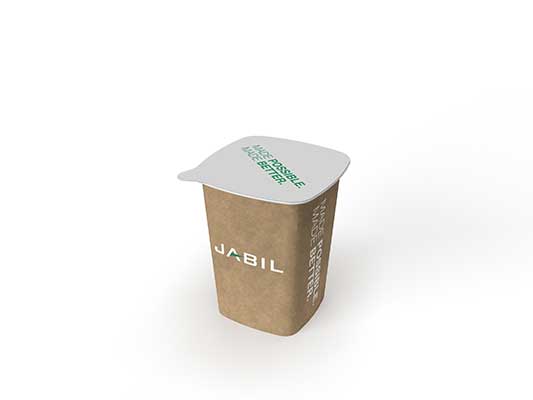Awareness of plastic pollution leads to changes for consumer packaged goods driving them to use less plastic and incorporate paper packaging.

By Romeo Graham, Director of Technology, Packaging, Jabil
As more and more companies focus on sustainability, plastic packaging is often at the center of those discussions. Growing awareness of plastic pollution has influenced public opinion and led to significant changes for consumer packaged goods (CPG) brands, driving them to use less plastic and incorporate as much recycled material as possible, including paper packaging. More than two-thirds (68%) of companies surveyed in Jabil’s 2022 Sustainable Packaging Survey said they are working to implement paper-based packaging, and nearly half (49%) said their highest sustainable packaging priority is implementing paper-based packaging.
Paper’s simplicity offers significant sustainability advantages, such as recyclability and renewability, but it creates complexities for brands used to working with plastic to protect their products or to create eye-catching branded shapes and designs. Paper is limited in its ability to function on its own as packaging. Cardboard boxes aside, many forms of paper packaging require some amount of plastic to make it functional, protecting the product inside from leaks, pathogen growth, and exposure to light and oxygen. Containers for liquid products like broth or soup use paper that is coated and often includes a plastic closure that can make at least part of the package unrecyclable. Other paper packaging options such as padded envelopes are often lined with plastic, making them difficult to recycle.
The use of coated paper — think milk or juice cartons — has historically presented problems for brands. Not all paper facilities can process coated paper, and those that can recycle the material require large amounts of water and energy to separate the paper fibers from the plastic layer. This resource-intensive process generates a relatively small amount of recyclable paper, and the process also yields plastic that must be landfilled.
However, the outlook for the recyclability of paper packaging that includes some plastic is changing. Material recovery facilities (MRFs) are beginning to implement systems that can recover cups coated with one or two layers of polyethylene (PE), like paper coffee cups. This opens the door for the recycling of other paper-based packaging that includes the use of some non-paper materials for barrier layers, closures, and other functional elements.
At this point, it is unclear whether it will be possible to completely eliminate all plastic from paper packaged products that need high levels of barrier protection, such as personal and home care liquids, refrigerated or frozen foods, and medicines. Instead, reducing the use of plastics in packaging has become an essential driver in the adoption of paper-based packaging for CPGs.
There are strategies and design considerations for adopting paper packaging that can help CPG brands overcome its limitations while reducing plastic content, including limiting the use of coatings and making plastic components that can easily be separated. Encouraging consumers to recycle paper packaging is key to its sustainability. Using post-consumer recycled paper in the construction of paper packaging, while taking ownership of their own supply chain by developing a source of recycled material, is also critical for CPG brands to ensure the sustainability of the packaging itself.
By controlling the recycling flow, brands gain unprecedented visibility into the circularity of their production process. Organizations can also create streams to recycle plastic components that are often integrated with paper packaging, such as plastic liners or caps.
Paper containers, including coated paper packaging, have traditionally only been folded in box-style configurations, making it nearly impossible to use for liquid products such as shampoo or lotion. By combining lightweight plastic liners to create the inner layer of the container with molded fiber outer shells, brands can retain brand equity in a wide range of formats and shapes to suit their specific needs — creating branded designs that also protect the products inside.
Unlike coated paper, which has limited recyclability, separable paper shells and plastic linings can both be recycled into post-consumer material, eventually becoming the next generation of packaging. Improvements to the molding and automated assembly processes used in paper packaging can also increase the adoption rate of the material. As brands, producers, and recyclers work together to change the landscape of recyclable paper packages, we can get closer to reaching reduced plastic in packaging.
Consumer packaged goods brands have set lofty plastic reduction goals. To the average consumer, a single company cutting their plastic use 20% may sound like a drop in the bucket. However, zoom out to consider that all 500 signatories of the New Plastics Economy Global Commitment have made the same pledge; that means 40 million barrels of oil that would have previously become plastic will stay in the ground.
To reach these goals, companies must not only be committed to reducing their use of plastic packaging, but also engage in the development, design, and use of more sustainable and renewable materials like paper.

About the Author:
Through almost two decades of industrial design and CAD experience, Romeo has worked to improve product development and the efficiency of design processes. His pragmatic approach supports innovation in packaging, equipment design and process. He is passionate about technology in the discipline of design and evidence-based, real-world problem solving. Starting in 2008, Romeo provided design services as part of a consultancy to ecologic brands and helped develop and launch the world’s first commercial paper bottle. After joining ecologic as VP of design in 2017, Romeo continued to lead design and technology development through the Jabil acquisition in early 2021.
In this episode, I sat down with Beejan Giga, Director | Partner and Caleb Emerson, Senior Results Manager at Carpedia International. We discussed the insights behind their recent Industry Today article, “Thinking Three Moves Ahead” and together we explored how manufacturers can plan more strategically, align with their suppliers, and build the operational discipline needed to support intentional, sustainable growth. It was a conversation packed with practical perspectives on navigating a fast-changing industry landscape.